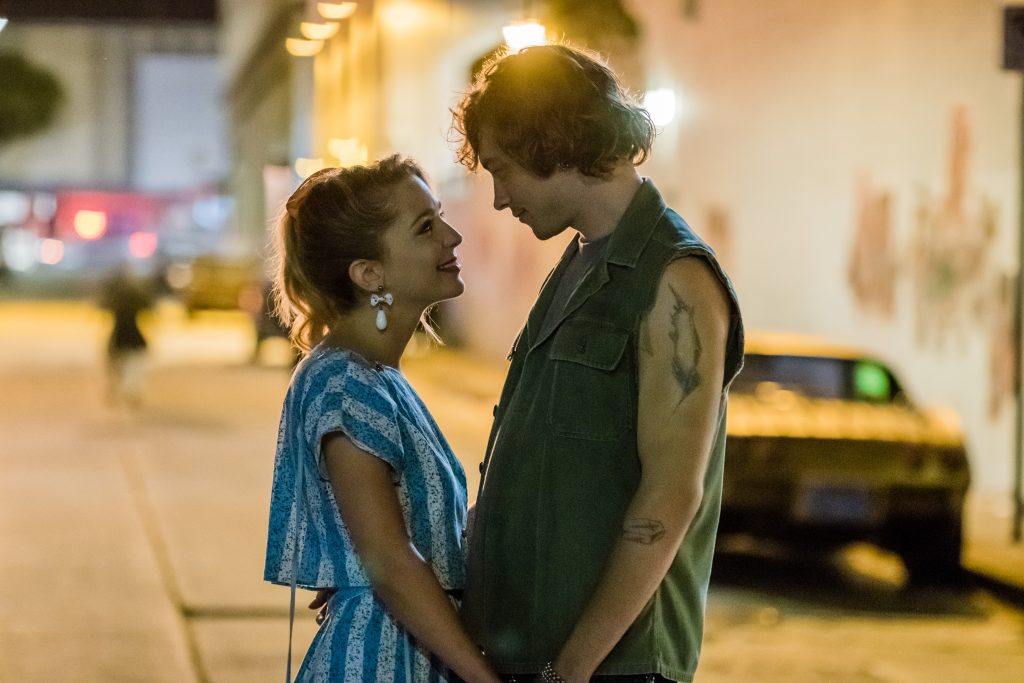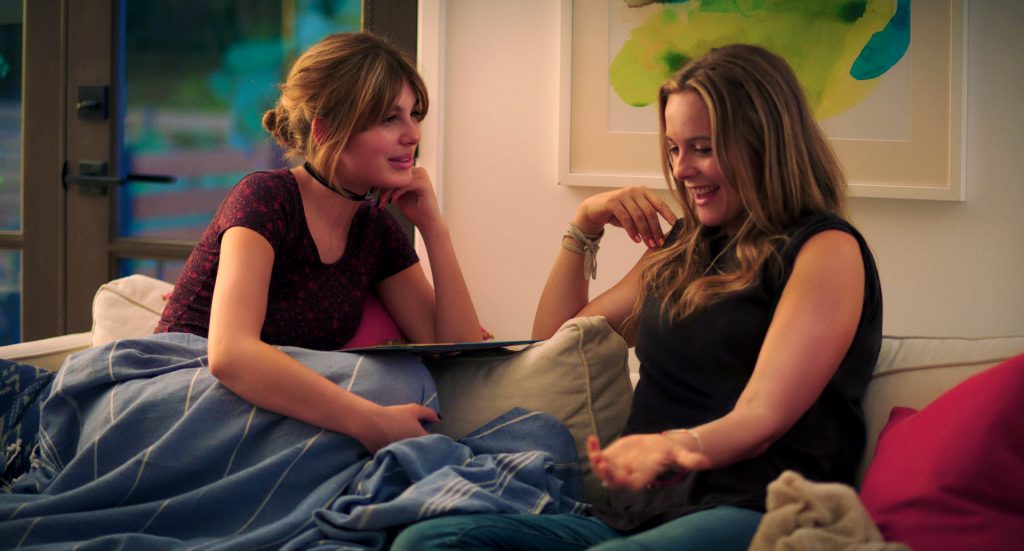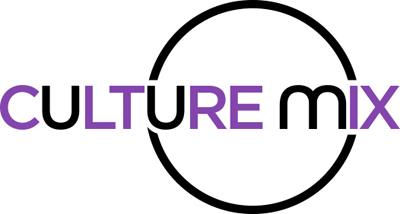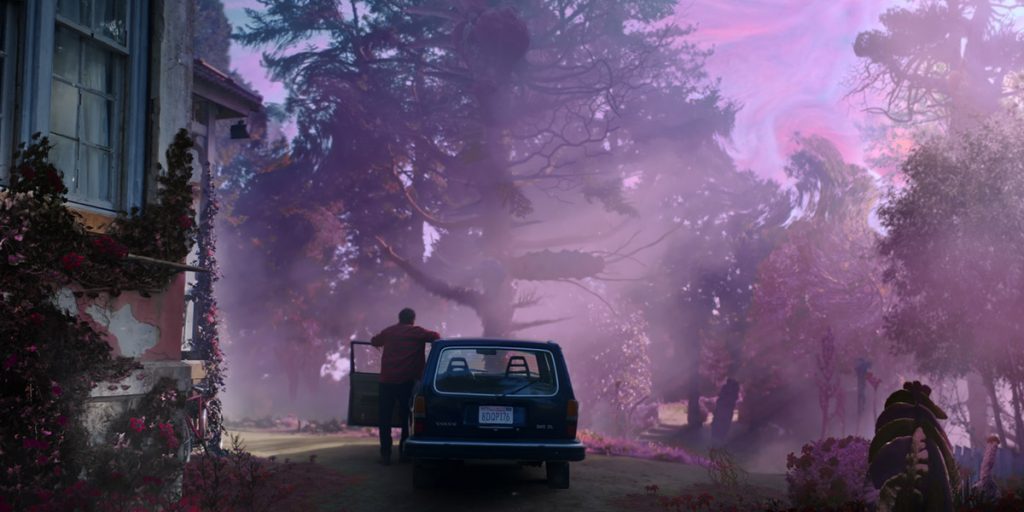May 8, 2020
by Carla Hay

Directed by Rachel Lee Goldenberg
Culture Representation: Taking place in the Los Angeles area, this musical remake of the 1983 romantic comedy “Valley Girl” has a predominantly white cast of characters (with some African Americans, Latinos and Asians) representing the middle-class.
Culture Clash: A sheltered San Fernando Valley “good girl,” who’s about to graduate from high school, has a romance with a “bad boy” musician from Hollywood, much to her friends’ disapproval.
Culture Audience: “Valley Girl” will appeal mostly to fans of the original “Valley Girl” movie or fans of 1980s pop music, but they will probably be disappointed in this musical remake, which is too slick for its own good.

The 1983 romantic comedy “Valley Girl” (starring Nicolas Cage and Deborah Foreman) is the kind of movie that doesn’t need to be remade/re-imagined/rebooted for a modern audience, because it’s a movie about a particular youth subculture that’s meant to stay in the past and shouldn’t be resurrected. Although the 2020 musical remake of “Valley Girl” (directed by Rachel Lee Goldenberg) wisely chose to make the movie primarily as a flashback memory to the ’80s, almost everything about this musical smacks of an inauthentic, forced recreation of the effortless 1980s charm that made the original “Valley Girl” movie a cult classic.
In the beginning of the “Valley Girl” musical remake, a pouty, young woman named Ruby (played by Camila Morrone), who’s in her early 20s, stumbles out of a nightclub and asks her mother (whom she still lives with) to come pick her up from the club. Ruby is apparently too tipsy to drive and apparently doesn’t want to call a taxi or ride-sharing service. When they get home, Ruby tells her mother Julie (played by Alicia Silverstone) that she’s in a bad mood because she just broke up with her boyfriend.
The mother is supposed to be the Julie Richman character who was the teenage titular protagonist in the original “Valley Girl” movie. Julie is now a middle-aged fashion designer, who has fond and rosy memories of her teenage years in California’s San Fernando Valley, where she still lives.
As a San Fernando Valley teenager in the ’80s, Julie’s life was like a carefree bubble that revolved around school, going to shopping malls (like the famous Sherman Oaks Galleria), dating, hanging out at the beach, and going to parties with other teens, usually at someone’s house. (Frank Zappa’s 1982 song “Valley Girl,” featuring vocals by his then-teenage daughter Moon Unit Zappa, inspired the idea for the 1983 “Valley Girl” movie. The Zappas were not involved in the movie, and Frank Zappa lost a lawsuit that he filed to prevent the film from being made.)
When she was a senior in high school, Julie fell in love for the first time with a slightly older Hollywood rocker named Randy, who was played by Cage in the original “Valley Girl” movie. As for who Ruby’s father is, he’s mentioned but not seen in the “Valley Girl” remake, which reveals at the end of the film whether or not Randy and Julie ended up living happily ever after.
Julie is very sympathetic about her daughter’s boyfriend breakup, but Julie also starts to tell Ruby about the “good old days,” when her name was Julie Richman and she was a very sheltered teenager in the early-to-mid-80s. (Although the original “Valley Girl” was released in 1983, the ’80s music in the “Valley Girl” musical remake was released in or before 1984. Only true music trivia buffs would notice this change in the movie’s soundtrack.)
Julie’s daughter tries to pretend she doesn’t care about her mother’s nostalgic memories, by groaning to her about her boyfriend problems: “You wouldn’t understand!” And that’s when Julie launches into her “let me tell you about when I was young” story. The rest of the movie occasionally cuts back to the middle-aged Julie and her daughter for exposition purposes, but the majority of the film consists of the flashback memories of Julie, with the characters from the ’80s often singing their dialogues, since this is a musical.
Here we go. Get ready for the cheesiness. Although Jessica Rothe as the teenage Julie does a fairly good job as a singer, she is not convincing at all as a naïve, straight-laced high schooler, which is what Julie is supposed to be. Rothe looks like she’s graduated from high school years ago, instead of someone who’s supposed to still be in high school. Putting her in cutesy and frilly ’80s outfits doesn’t make her look like a teenager.
Deborah Foreman, who played the teenage Julie in the original “Valley Girl” had a mix of innocence and sexiness that made her irresistible to a lot of guys in her orbit. Rothe (who was in her early 30s when she made this “Valley Girl” remake) looks like she’s playing dress-up as a teenager. Because she looks way past the age of a student in high school, it looks ridiculous for her to play such a sheltered goody-two shoes teen. It’s not quite as bad of an age miscast as Olivia Newton-John in the movie “Grease,” but it’s pretty close. At least “Grease” was a great musical. This version of “Valley Girl” is most definitely not.
As for “bad boy” rocker Randy, the original “Valley Girl” had Cage playing him as a kind of a misfit weirdo who didn’t care about the social taboos of a sheltered high school girl from the San Fernando Valley dating a “freak” from Hollywood. In this musical version of “Valley Girl,” there’s nothing quirky, dangerous or even edgy about Randy, who’s played by Josh Whitehouse, in a very bland performance and with very limited singing talent.
In this remake, Randy looks more like he wants to be a heartthrob teen idol (like John Stamos was back in the early ’80s), instead of being a slightly scuzzy, down-on-his-luck rocker, which is what the Randy character is supposed to be. Even the tattoos that the Randy character has in this “Valley Girl” remake look fake, because they probably are. Randy in both “Valley Girl” movies is supposed to be slightly older than Julie, which is one of the reasons why their relationship is slightly taboo. While in the original movie, Cage looked the part, Whitehouse actually looks younger than Rothe, which he is in real life.
The nightclub scenes in this remake also don’t look real at all. You can tell it’s a movie set, compared to the original “Valley Girl” which filmed on location at a real nightclub. The nightclub where the original “Valley Girl” was filmed was called The Central back then, but it became more famous in the 1990s when it was renamed the Viper Room. In the original “Valley Girl,” there was a scene with The Plimsouls performing their song “A Million Miles Away” at the club. In the remake, the female rock duo Deap Vally performs the song.
In fact, almost everything about the “Valley Girl” remake (written by Amy Talkington) feels overly sanitized. It scrubs out all the adult content from the original movie (in other words, some of the funniest scenes) and turns this film into a too-cutesy musical. The only nudity in the remake is when some male students briefly moon someone at the high school. There’s no drug use in the remake, and sex is hinted at but not shown.
The costumes in the “Valley Girl” remake also look very much like costumes (and some of it is intentional, since many of the movie’s scenes take place at a costume party), while the movie’s hair, makeup and production design for the San Fernando Valley scenes are overly exaggerated in pastels and neon. Perhaps this “movie set” look to the film serves a purpose, since it’s supposed to represent the glossy memories of someone nostalgic about their teenage years in the ’80s. But people who’ve seen the original “Valley Girl” (which was directed by Martha Coolidge) will be turned off by this remake’s glibness.
Although the remake removed the gritty and realistic aspects of the original “Valley Girl,” the plot of the original “Valley Girl” is mostly the same in this musical remake, with some notable differences. In both “Valley Girl” movies, Julie (who’s a popular girl at her school) breaks up with a guy that most people expect someone like her to date: a preppy jock who’s also popular at school. But he also happens to be very self-centered, cocky and possessive, which is why Julie breaks up with him. He swears that she’ll regret it, and he arrogantly predicts that she’ll beg him to take her back.
In both movies, Julie meets Randy shortly after the breakup. And it’s the kind of scene where they look at each other in a way that’s obvious that they’re attracted to each other and will eventually get together. In the original “Valley Girl,” Randy and Julie meet at a house party, where he’s shown up uninvited. In the remake, Randy and Julie meet briefly on the beach, and then have their first major flirtation later at a house party.
In the original “Valley Girl,” Julie’s obnoxious ex-boyfriend was named Tommy (played by Michael Bowen). In the “Valley Girl” remake, the ex-boyfriend is named Mickey Bowen (get it?), and he’s played by YouTube star Logan Paul, who’s famous for also being obnoxious in real life, so there doesn’t have to be a lot of acting from him. It’s unknown if the character was named Mickey before or after the filmmakers decided to put Toni Basil’s hit “Mickey” as a big musical number in the film. Yes, it’s as cringeworthy as it sounds.
The choreography by Mandy Moore (of “La La Land” and “So You Think You Can Dance” fame) is actually one of the better aspects of the “Valley Girl” remake. It’s just too bad that the watered-down story and corny dialogue make this movie much more inferior to the original. The remake is essentially a “jukebox musical” with a lot of ’80s hits stuffed into the plot.
There are a few modern updates to the “Valley Girl” remake. The cast is a little more diverse than the first “Valley Girl” film. In the original, all the girls in Julie’s close circle of friends are thin and white. In the remake, Julie’s clique includes an African American named Loryn (played by Ashleigh Murray), whose dream is to be a dancer in music videos, especially for her idol Janet Jackson; plus-sized Stacey (played by Jessie Ennis), who’s unfortunately the butt of jokes and not treated very well by some of her so-called “friends”; and petty-minded Karen (played by Chloe Bennet), who ends up dating Mickey after Julie breaks up with him.
In the original “Valley Girl,” Julie’s friend Loryn (played Elizabeth “E.G.” Dailey) is the one who fools around with Julie’s ex-boyfriend at a party, and they keep their short fling a secret. In the remake, Mickey and Karen openly date each other after Julie has dumped him. His rebound relationship with Karen essentially ends Karen’s friendship with Julie.
But in both movies, all of the San Fernando Valley girls in Julie’s clique still have the same stuck-up attitude about Hollywood, which they think is a place for freaks and weirdos. This social snobbery is why Julie’s friends pressure her to break up with Randy and get back together with her ex-boyfriend. If you know the formula of romantic comedies, you can guess how Julie handles this conflict and how it gets resolved in the end.
Both movies also have teen parties that are chaperoned by adults. Fun fact: Original “Valley Girls” co-stars Foreman and Dailey have cameos in the “Valley Girl” remake. Foreman plays someone who compliments Julie in a store that sells prom dresses (how very meta), while Dailey plays a drunk parent at one of the teen parties. However, the remake doesn’t have the original “Valley Girl” subplot of a “Mrs. Robinson”-type character trying to seduce the teenage guy whom her daughter wants for herself.
Julie’s parents are very different in each movie. In the original “Valley Girl,” Julie’s former hippie parents are much more lenient (her father also smokes marijuana in the movie) than Julie’s parents in the “Valley Girl” remake. For example, in the original “Valley Girl,” Julie’s parents Steve and Sarah (played by Frederic Forrest and Colleen Camp), who run a health-food restaurant, were okay with her staying out all night and dating Randy. In the remake, Julie’s parents Steve and Diana (played by Rob Huebel and Judy Greer) are much more conservative (Steve is a corporate business type), much more protective of Julie, and they don’t approve of her dating Randy.
Another big difference is that in the original “Valley Girl,” Randy’s family is not seen or mentioned at all. But the “Valley Girl” remake goes more into the backstory of Randy’s family, when he reveals that his father abandoned him, and his mother kicked Randy out of their home. And the original “Valley Girl” never showed the bachelor pad where Randy lived (which made him kind of mysterious), whereas the remake shows that Randy (who’s a wannabe rock star) lives in a dumpy apartment in Hollywood with his two band mates: a lesbian bass player named Jack (played by Mae Whitman) and a kooky drummer named Sticky (played by Mario Revolori). Jack is Randy’s best friend/sidekick, which was the role of Fred Bailey (played by Cameron Dye) in the original “Valley Girl” movie.
The “Valley Girl” remake also gives Julie career ambitions, which she did not have in the original movie. In the musical remake, Julie is an aspiring fashion designer who dreams of going to the Fashion Institute of Technology in New York City, but she’s pressured to conform and go to California State University at Northridge, a school that many of her peers from high school also plan to attend.
The other girls in Julie’s Valley Girl clique only have ambitions to go to college so that they can find a husband. As Loryn says to her friends while they’re sunning themselves at the beach, “If I’m not married by the time I’m 23, I’ll kill myself!” If that sounds like an outdated mindset, even for 1980s California, consider that a lot of teenage girls and young women still think this way in very conservative communities.
The “Valley Girl” remake’s hokey dialogue and mediocre acting might be forgivable, but the movie does something that’s pretty unforgivable for fans of the original “Valley Girl” movie. It changed the plot so that Modern English’s “I Melt With You” (the signature song from the original “Valley Girl” soundtrack) is supposed to be written by Randy for Julie. In other words, that means Randy and his band play “I Melt With You” in a serenading scene that’s as dumb as you think it is. Pure garbage.
Since the “Valley Girl” remake ruined “I Melt With You,” here’s a list of ’80s songs that the movie’s cast members remade for the musical scenes, in a less offensive but still fairly cheesy way: Cyndi Lauper’s “Girls Just Want to Have Fun”; Joan Jett’s “Bad Reputation”; a-ha’s “Take on Me”; The Cars’ “You Might Think”; A Flock of Seagulls’ “Space Age Love Song”; The Cure’s “Boys Don’t Cry”; Queen and David Bowie’s “Under Pressure”; and a medley of Depeche Mode’s “Just Can’t Get Enough,” Madonna’s “Material Girl,” Hall & Oates’ “I Can’t Go for That (No Can Do),” and Soft Cell’s cover version of “Tainted Love.”
There are also some songs in the movie that are the original artists’ studio recordings, such The Cars’ “Magic,” Duran Duran’s “Rio,” Men at Work’s “Be Good Johnny,” Run-DMC’s “It’s Like That” and Men Without Hats’ “Safety Dance.” It’s obvious that the filmmakers spent a great deal of the movie’s budget on licensing these hit songs, because there doesn’t appear to have been much of the budget invested in creating a quality film.
Orion Classics released “Valley Girl” in select U.S. drive-in theaters, on digital and on VOD on May 8, 2020.


